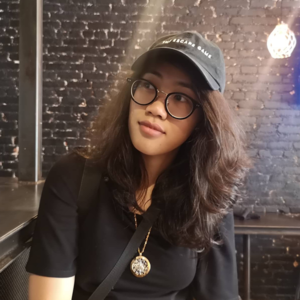Diploma Programme (DP) graduate Liezl Bitas reflects on the need for rest during the COVID-19 (Coronavirus) pandemic. She shares the benefits that you can reap by taking time for yourself, such as increased creativity. This is her third story in our graduate voices series.

We have just spent nearly a year at home—that was the reality that dawned on me, and most of the world, as we made our way into March 2021. As a writer who finds her most productive hours cozied up in a soft sweater and a cup of black tea, I thought this would be a dream come true.
An immediate lockdown plan planted deep in my psyche: Devote the obligatory time windows to classes and work, then spend the rest on personal projects that have burrowed themselves deep in my to-do pile for hyperbolic centuries. That feature-length comedy screenplay that I’ve been outlining on loose sheets of scratch paper would finally materialize.
Inspiration boomed as top publications released one motivational work-from-home article after another. They shone a light on the bright side of social isolation amid a health panic, as it provided Shakespeare with a golden opportunity to pen King Lear and Newton the inertia to set his theory of gravity in motion.
Recent news lauded the great minds that birthed creative works in this decade’s pandemic, too. Taylor Swift composed and recorded not one, but two No. 1 studio albums. Sam Levinson wrote and shot two special episodes of his HBO hit drama series, Euphoria. Netflix released an aptly named compilation of ’homemade’ short films conceived in 2020. And, though critic and viewer reviews leave something to be desired, a Michael Bay-produced film, Songbird, was inspired by and shot during the pandemic.
“[I was] struggling to dig up any tinder for my creativity bonfire”
Fueled by these inspirational stories and a lot of home-brewed coffee, I sat in front of my screen, hovered my buzzing fingertips atop my new keyboard … and watched a cursor frustratingly blink at the top of a blank white page.
No big deal. It’s just good ol’ writer’s block, I thought.
Skip ahead months later. I found myself waking up mere seconds before I had to sign into a Slack channel or a Zoom class, dragging my feet to get a third cup of instant coffee just to keep my eyes open through the afternoon, and struggling to dig up any tinder for my creativity bonfire. And the more I tried to fan the flame, the faster the embers flickered.
Burnout: ‘The harder we try’
This inability to make progress on my screenplay wasn’t really writer’s block—it was burnout.
Motivational doctrine preaches to, “never give up”, and, “just do it”, and other mantras that would make for a trendy statement shirt; but just as firewood and coal have their limits, so too does creative energy.
“Contrary to my own hustle mindset, rest is not a waste of time”.
English philosopher Aldous Huxley coined this concept the Law of Reversed Effort, which simply said means, “the harder we try with the conscious will to do something, the less we shall succeed”.
In December 2020, I attended a screenwriter’s webinar in which Dr Woodruff Johnson, a Los Angeles-based clinical psychologist, urged writers to stop ramming into their mental brick walls and instead, “get away from it.” He suggested, on top of redirecting artistic endeavors into something else such as painting or playing music, tuning into a key habit: Rest.
Contrary to my own hustle mindset, rest is not a waste of time. Authors and researchers like Chris Bailey (The Productivity Project, Hyperfocus: How to Work Less to Achieve More) and Alex Soojung-Kim Pang (Rest: Why You Get More Done When You Work Less) sing praises for cultivating one’s energy and testify that rest is a vital part of productivity and creativity.
In an article published through UC Berkeley’s Greater Good magazine, Pang writes, “Even in our brain’s resting state—when we are not directly focused on a taste—it’s still active, engaging its ‘default network'”.
This default network, also called default mode network or DMN, is composed of a number of regions in the brain that are active during tasks involving recalling the past or envisaging the future (Buckner, 2013). So, when our DMN lights up, even during idle moments, we can solve problems and employ creativity. Engaging these regions, Pang recommends, includes both our typical idea of rest (sleep) and understanding when to (and that it’s okay to) stop.
Social isolation and the ‘lone genius’ myth
“Even as a self-professed introvert, I realize how integral even the smallest of small talk with a stranger can send plumes of ideas coursing through my neurons”.
Another significant facet of this months-long lockdown is social distancing. Though it’s true many a creative mind finds bursts of artistic output in alone time, the kind of long-term isolation the COVID-19 (Coronavirus) era has brought is uncharted territory.
The Kaiser Family Foundation has conducted surveys on the mental health of Americans in 2020. They cite, “a broad body of research [linking] social isolation and loneliness to poor mental health”, and found in their own surveying that isolation from sheltering in place seemed to compound the negative mental health effects from COVID-19-related stress in U.S. adults.
Prior to the onslaught of COVID-19, there has been some research on the positive impact of short-term sensory deprivation, such as in flotation therapy, on promoting creativity. This can very well corroborate our modern idea of the ‘lone genius’—the Dickinson-esque recluse whose solitude equates fertile ground for artistic produce. However, an article by Alfonso Montuori and Ronald Purser (1995) deconstructs this notion, dubbing it a myth. They connect the, “cult of the genius”, with the rise of individualism during the Renaissance—an association that has continued even until today.
According to Montuori and Purser, this is a romanticized view of creativity and innovation, which are often fostered in environments wherein there is freedom to work on areas that pique one’s interest, encouragement toward nonconformity and—here’s the clincher—stimulating social interaction.
They reference research (Kelley and Caplan, 1993) that found networking with colleagues to be one of the, “essential features that actually distinguishes the more innovative scientists from the merely competent ones”. Moreover, they enumerate improvising jazz groups, artists and authors mingling in cafes, and scientists discussing in conferences as examples of wells of creative juice.
While we’re advised to stay home to do our part to minimize the spread of a deadly disease, cafes, jazz clubs and conferences aren’t exactly within reach. Even as a self-professed introvert, I realize how integral even the smallest of small talk with a stranger can send plumes of ideas coursing through my neurons.
Creativity is hard
“Let’s not forget the slew of masterful films, artworks, songs and more that came to be after their creators took a break”
As I write this, with Taylor Swift’s Evermore album blaring on loudspeaker, and I marvel at her—and her team of cowriters’, fellow musicians’, producers’, et cetera—ability to churn such an inspired work of art during one of the strangest times in Earth’s history. But let’s not forget the slew of masterful films, artworks, songs and more that came to be after their creators took a break, whether it be a celebratory R&R or a well-earned sabbatical … or perhaps a global health crisis.
So, while some may find the time saved from the two-way commute and other ‘normal’ social activities we used to do pre-pandemic to be an opportune window to put their creative minds to work, others may find that same time to be a chance to get a full night’s sleep, watch some reality TV and discover healthy ways to cope with the unprecedented circumstances we’re in.
Creativity is hard, but so is the year 2020 and the months that spill over as we wait for herd immunity to take a hold.
As I type out the final words of this post, I’m already eyeing a steaming mug of black tea and the next movies on my winter watchlist. That screenplay will get written, but my brain’s going to need enough fuel to marathon all the way to, “FADE TO BLACK”.
For now, the overworked mind can take a breather, allow itself to be ready to get cracking again, and listen to itself say: Relax. We have time.

Liezl Bitas is a graduate of British School Manila in Manila, Philippines. She is currently majoring Film Production in California State University, Northridge, where she learns to further hone her craft as a filmmaker and screenwriter. Since 2018, she has also been a writer for the university’s online publication, CSUN Today. You can reach her on LinkedIn here.
If you enjoyed this story, consider reading more below:



